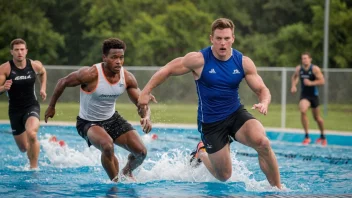In the realm of water sports, athletes are constantly seeking ways to improve their performance while ensuring their safety. The integration of technology has revolutionized how athletes train, compete, and monitor their progress. From advanced tracking devices to smart gear, these innovations are designed to enhance performance and provide critical safety measures. Here, we explore five key ways technology is transforming water sports performance while keeping athletes safe.
Wearable Performance Trackers
Wearable technology has become a staple in many sports, and water sports are no exception. Devices such as smartwatches and fitness bands allow athletes to monitor their heart rate, calories burned, and even stroke count while in the water. These trackers provide real-time feedback, enabling athletes to adjust their techniques on the fly. Additionally, some advanced trackers come equipped with GPS functionality, allowing users to map their routes and analyze their speed and distance traveled. This data can be invaluable for refining techniques and improving overall performance.
Smart Swim Goggles
Smart swim goggles are an exciting advancement in water sports technology. These goggles often feature heads-up displays that provide athletes with instant access to critical performance metrics such as lap times, stroke counts, and pace without having to stop and check a watch. Some models even sync with mobile apps to provide deeper insights into training sessions. This technology allows swimmers to focus on their form and technique rather than getting distracted by timing devices, leading to improved performance and safety during workouts and competitions.
Advanced Surfboard Sensors
In surfing, performance tracking can be enhanced through the use of sensors embedded in surfboards. These sensors measure various metrics, including speed, wave height, and even the angle of turns. By analyzing this data, surfers can gain insight into their riding style and identify areas for improvement. This technology not only helps surfers refine their skills but also assists in ensuring they are riding safely by providing alerts on dangerous conditions or areas to avoid, thereby enhancing overall safety in the water.
Virtual Reality Training
Virtual reality (VR) is making waves in the training regimens of water sports athletes. By simulating various water conditions and scenarios, athletes can train in a controlled environment to improve their skills without the risks associated with actual water training. This technology allows for repetition and experimentation in a safe setting, enabling athletes to hone their techniques before hitting the water. Furthermore, VR can help athletes visualize performance strategies, leading to greater confidence and better execution during real competitions.
Safety Gear Innovations
With the rise of technology in water sports, safety gear has also seen significant advancements. Modern life jackets and wetsuits often integrate flotation devices that automatically adjust based on water conditions, ensuring optimal buoyancy. Additionally, helmets designed for water sports are now equipped with sensors that can detect impacts and alert emergency contacts if necessary. These innovations not only enhance performance by allowing athletes to push their limits but also provide peace of mind through improved safety features.
In conclusion, the role of technology in tracking and enhancing performance in water sports is undeniable. From wearable devices that monitor vital stats to smart gear that improves training and safety, athletes today have access to tools that can significantly elevate their performance levels while ensuring their safety. As technology continues to evolve, it promises even greater advancements that will further shape the future of water sports.






